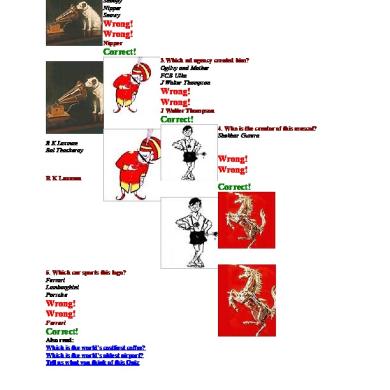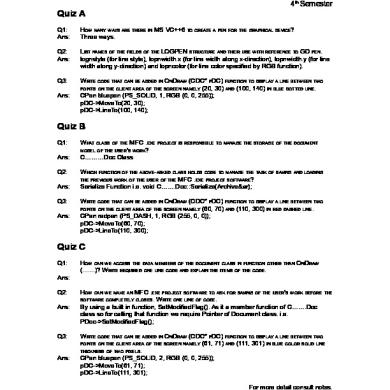(13)answers To Quiz 13.doc
This document was uploaded by user and they confirmed that they have the permission to share it. If you are author or own the copyright of this book, please report to us by using this DMCA report form. Report DMCA
Overview
Download & View (13)answers To Quiz 13.doc as PDF for free.
More details
- Words: 936
- Pages: 5
Answers to the questions in Quiz 13: 1. Use the AD curve and long-run AS curve to explain the classical analysis of economic growth and inflation. Answer: There are two important forces that govern the economy in the long-run. These forces are technological progress and expansionary monetary policies.
Technological progress shifts the long-run aggregate supply curve to the right.
The central bank increases the money supply over time, which shifts the aggregate demand curve to the right.
The result, as shown in the above figure, is growth in output and continuing inflation (increases in the price level over time.) 2. Use the AD-AS model to explain how a recession happens. How do policymakers eliminate a recession? Answer: A recession is caused by a decline in the aggregate demand.
That is, the aggregate demand curve shifts to the left, causing a short-run decline in output (with a rise in unemployment) and a decline in the price level (see Figure a below).
This situation is consistent with a downward movement along the Phillips curve from point A to point B (see Figure b below).
To eliminate a recession, policymakers can implement an expansionary monetary policy and/or an expansionary fiscal policy.
1
3. Use the AD-AS model to explain how a boom happens. How do policymakers ease a boom? Answer: A boom is caused by an increase in the aggregate demand.
That is, the aggregate demand curve shifts to the right, causing a short-run increase in output (with a decline in unemployment) and a rise in the price level (see Figure a below).
This situation is consistent with an upward movement along the Phillips curve from point A to point C (see Figure b below).
To ease a boom, policymakers can implement a contractionary monetary policy and/or a contractionary fiscal policy.
2
4. Use the AD-AS model to explain how a stagflation happens. Answer: A stagflation is caused by a decline in the short-run aggregate supply.
The short-run aggregate supply curve shifts to the left, causing a short-run decline in output (with a rise in unemployment) and an increase in the price level (see Figure c below).
This situation is consistent with a shift to the right in the Phillips curve. An increase in unemployment is associated with an increase in inflation (see Figure d below).
Definition of stagflation: a period of declining output (or real incomes), rising unemployment and rising prices.
5. Explain what causes movements along the Phillips curve. Explain what causes the Phillips curve to shift. Answer:
Any factor that causes a change in aggregate demand (and therefore shifts the AD curve) results in a movement along the Phillips curve.
Any factor that causes a change in aggregate supply (and therefore shifts the SRAS curve) results in a shift in the Phillips curve.
3
6. Explain why the Phillips curve is vertical in the long-run. Answer: In the long run, a change in money supply has no real effects.
This means that a change in money supply cannot affect the factors that determine the natural unemployment rate.
Thus, in the long run, we would not expect a relationship between unemployment and inflation.
This must mean that, in the long run, the Phillips curve is vertical at the natural rate of unemployment.
The vertical Phillips curve occurs because, in the long run, the aggregate supply curve is vertical as well.
Thus, increases in aggregate demand lead only to changes in the price level and have no effect on the economy’s level of output.
Thus, in the long run, unemployment will not change when aggregate demand changes, but inflation will.
Note that the long-run aggregate-supply curve occurs at the economy’s potential output; thus, the long-run Phillips curve occurs at the natural rate of unemployment.
4
7&8. What are the LR government policies? What are the SR government policies? Explain how these policies help promote economic growth. Answer: From Unit 8, the long-run government policies include: i. encouraging saving and investment; ii. taking advantage of the Catch-up effect; iii. encouraging investment from abroad; iv. providing free education; v. promoting property right and political stability; vi. encouraging free trade; vii. the control of population growth, and viii. encouraging research and development.
These policies are intended to make the long-run trend in real GDP steeper.
A steeper long-run trend in real GDP means shorter time to double real GDP and thus faster economic growth.
From Unit 12, the short-run government policies include both monetary and fiscal policies.
Using these policies, policymakers are able to promote economic growth by stabilizing short-run economic fluctuations (or the actual real GDP) around the long-run trend in real GDP.
9&10. Explain how an expansionary monetary policy works. Explain how an expansionary fiscal policy works. Explain which policy is more effective in stabilizing economic fluctuations. Answer: An expansionary monetary policy (or an increase in money supply) works through reducing the interest rate which encourages investment resulting in higher aggregate demand. Firms respond to higher aggregate demand by increasing output and employment.
An expansionary fiscal policy (or an increase in government spending) works through increasing aggregate demand. Firms respond to higher aggregate demand by increasing output and employment. o The interest rate increases, when the government finances spending through borrowing from the public. The increase in the interest rate crowds out part of the increase in aggregate demand (through reducing investment). Because of this crowding-out effect, an expansionary fiscal policy is less effective than an expansionary monetary policy in stabilizing the economy.
5
Technological progress shifts the long-run aggregate supply curve to the right.
The central bank increases the money supply over time, which shifts the aggregate demand curve to the right.
The result, as shown in the above figure, is growth in output and continuing inflation (increases in the price level over time.) 2. Use the AD-AS model to explain how a recession happens. How do policymakers eliminate a recession? Answer: A recession is caused by a decline in the aggregate demand.
That is, the aggregate demand curve shifts to the left, causing a short-run decline in output (with a rise in unemployment) and a decline in the price level (see Figure a below).
This situation is consistent with a downward movement along the Phillips curve from point A to point B (see Figure b below).
To eliminate a recession, policymakers can implement an expansionary monetary policy and/or an expansionary fiscal policy.
1
3. Use the AD-AS model to explain how a boom happens. How do policymakers ease a boom? Answer: A boom is caused by an increase in the aggregate demand.
That is, the aggregate demand curve shifts to the right, causing a short-run increase in output (with a decline in unemployment) and a rise in the price level (see Figure a below).
This situation is consistent with an upward movement along the Phillips curve from point A to point C (see Figure b below).
To ease a boom, policymakers can implement a contractionary monetary policy and/or a contractionary fiscal policy.
2
4. Use the AD-AS model to explain how a stagflation happens. Answer: A stagflation is caused by a decline in the short-run aggregate supply.
The short-run aggregate supply curve shifts to the left, causing a short-run decline in output (with a rise in unemployment) and an increase in the price level (see Figure c below).
This situation is consistent with a shift to the right in the Phillips curve. An increase in unemployment is associated with an increase in inflation (see Figure d below).
Definition of stagflation: a period of declining output (or real incomes), rising unemployment and rising prices.
5. Explain what causes movements along the Phillips curve. Explain what causes the Phillips curve to shift. Answer:
Any factor that causes a change in aggregate demand (and therefore shifts the AD curve) results in a movement along the Phillips curve.
Any factor that causes a change in aggregate supply (and therefore shifts the SRAS curve) results in a shift in the Phillips curve.
3
6. Explain why the Phillips curve is vertical in the long-run. Answer: In the long run, a change in money supply has no real effects.
This means that a change in money supply cannot affect the factors that determine the natural unemployment rate.
Thus, in the long run, we would not expect a relationship between unemployment and inflation.
This must mean that, in the long run, the Phillips curve is vertical at the natural rate of unemployment.
The vertical Phillips curve occurs because, in the long run, the aggregate supply curve is vertical as well.
Thus, increases in aggregate demand lead only to changes in the price level and have no effect on the economy’s level of output.
Thus, in the long run, unemployment will not change when aggregate demand changes, but inflation will.
Note that the long-run aggregate-supply curve occurs at the economy’s potential output; thus, the long-run Phillips curve occurs at the natural rate of unemployment.
4
7&8. What are the LR government policies? What are the SR government policies? Explain how these policies help promote economic growth. Answer: From Unit 8, the long-run government policies include: i. encouraging saving and investment; ii. taking advantage of the Catch-up effect; iii. encouraging investment from abroad; iv. providing free education; v. promoting property right and political stability; vi. encouraging free trade; vii. the control of population growth, and viii. encouraging research and development.
These policies are intended to make the long-run trend in real GDP steeper.
A steeper long-run trend in real GDP means shorter time to double real GDP and thus faster economic growth.
From Unit 12, the short-run government policies include both monetary and fiscal policies.
Using these policies, policymakers are able to promote economic growth by stabilizing short-run economic fluctuations (or the actual real GDP) around the long-run trend in real GDP.
9&10. Explain how an expansionary monetary policy works. Explain how an expansionary fiscal policy works. Explain which policy is more effective in stabilizing economic fluctuations. Answer: An expansionary monetary policy (or an increase in money supply) works through reducing the interest rate which encourages investment resulting in higher aggregate demand. Firms respond to higher aggregate demand by increasing output and employment.
An expansionary fiscal policy (or an increase in government spending) works through increasing aggregate demand. Firms respond to higher aggregate demand by increasing output and employment. o The interest rate increases, when the government finances spending through borrowing from the public. The increase in the interest rate crowds out part of the increase in aggregate demand (through reducing investment). Because of this crowding-out effect, an expansionary fiscal policy is less effective than an expansionary monetary policy in stabilizing the economy.
5
Related Documents

Answers To Quiz 2
December 2019 22
Quiz
November 2019 39
Quiz
May 2020 34
Quiz
November 2019 35
Quiz
May 2020 33
Quiz
October 2019 45More Documents from ""

(12)answers To Quiz 12.doc
November 2019 14
(9)answers To Quiz 9.doc
November 2019 19
(13)answers To Quiz 13.doc
November 2019 16
(11)answers To Quiz 11.docx
November 2019 13
(10)answers To Quiz 10.doc
November 2019 13